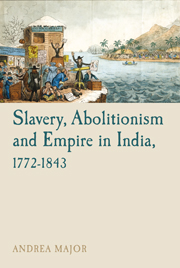Book contents
- Frontmatter
- Contents
- List of Illustrations
- Acknowledgements
- List of Abbreviations
- Glossary
- Some Prominent Figures in the British Parliament, the Abolitionist Movement and the East India Company
- Part I Other Slaveries
- Part II European Slaveries
- Introduction: Slavery and Colonial Expansion in India
- 2 ‘A Shameful and Ruinous Trade’: European Slave-trafficking and the East India Company
- 3 Bengalis, Caffrees and Malays: European Slave-holding and Early Colonial Society
- Part III Indian Slaveries
- Part IV Imagined Slaveries
- Conclusion: ‘Do Justice to India’: Abolitionists and Indian Slavery, 1839–1843
- Select Bibliography
- Index
3 - Bengalis, Caffrees and Malays: European Slave-holding and Early Colonial Society
from Part II - European Slaveries
- Frontmatter
- Contents
- List of Illustrations
- Acknowledgements
- List of Abbreviations
- Glossary
- Some Prominent Figures in the British Parliament, the Abolitionist Movement and the East India Company
- Part I Other Slaveries
- Part II European Slaveries
- Introduction: Slavery and Colonial Expansion in India
- 2 ‘A Shameful and Ruinous Trade’: European Slave-trafficking and the East India Company
- 3 Bengalis, Caffrees and Malays: European Slave-holding and Early Colonial Society
- Part III Indian Slaveries
- Part IV Imagined Slaveries
- Conclusion: ‘Do Justice to India’: Abolitionists and Indian Slavery, 1839–1843
- Select Bibliography
- Index
Summary
When tried for slave-trafficking in 1789, Danish captain Peter Horrebow expressed his surprise that such activity should be illegal, given that owning slaves was permitted in British India and public sales and auctions regularly took place in Calcutta. The EIC's 1774 prohibition of slave-trafficking allowed the sale or transfer of existing slaves, providing this was formalised by a written deed. The proclamation of 1789 similarly focused on preventing the export trade rather than interfering with domestic slavery in European or Indian homes. Moreover, when discussions about domestic and agricultural slavery in India began in the early nineteenth century, these were overwhelmingly conducted in the context of indigenous social and labour practices, rather than of the domestic economies of colonial European households. Yet many Europeans, including Britons, held Indian, African and Malay slaves as domestic servants in their homes in late eighteenth-century India. ‘[H]ardly a man or woman exists in a corner of this populous town’, Sir William Jones wrote of Calcutta in 1785, ‘who hath not at least one child slave.’ This ‘conspicuous presence of domestic slaves in Anglo-Indian households’, historian Margot Finn reminds us, ‘emerges clearly from an array of late-eighteenth- and early nineteenth-century manuscript sources. Physically visible, economically vital and philosophically perplexing, domestic slaves animate the archive of inventories, wills and private letters that documents social life in India under Company rule.’ They also appear, sometimes obliquely, in newspaper advertisements, judicial pronouncements and the official correspondence of EIC representatives.
- Type
- Chapter
- Information
- Slavery, Abolitionism and Empire in India, 1772–1843 , pp. 85 - 120Publisher: Liverpool University PressPrint publication year: 2012



